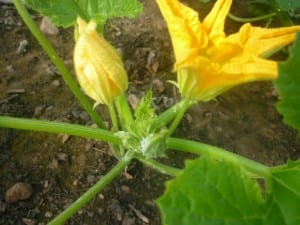Photo and Article By Carol Quish for UConn Extension
 Where are all my summer squash? Why do my plants have many blossoms and not squash? These are a few of the questions I hear about yellow and zucchini squashes when the squashes look like they should be setting fruit. Be patient, gardeners, squash will come.
Where are all my summer squash? Why do my plants have many blossoms and not squash? These are a few of the questions I hear about yellow and zucchini squashes when the squashes look like they should be setting fruit. Be patient, gardeners, squash will come.
Squash plants produce separate male and female flowers on the same plant. The male flowers contain the pollen, the male part the reproduction process. The female flowers have the ovary at their base. The ovary looks like a very small squash. This ovary will not develop and will be aborted,(dropped off), of the plant if pollen is not moved from the male flower to female. The process is called pollination, resulting in fertilization, then the ovary will develop into the fruit, the squash. The male flowers are produced and open a few days before the female flowers open. So the males are ready before the females. (I am not going to comment on this.)
The male flowers are on a long stem with no little squash at the flower base. The female shows the small squash.
Insects such as bees are the common pollinators of squash plants. They feed on the nectar in the flower, and in the process pick of pollen from the male flowers, dropping some in the female flower when the move into it. If all goes well, fertilization happens and the squash will develop.
A common pest insect of summer squash is the squash vine borer which lays eggs on the stems of the squash. The eggs hatch into a larva which tunnel into the stem to feed. Their feeding damages the inside of the stems and the water conducting vessels of the plant, causing part or entire collapse and wilt of the plant. The squash vine borer is a clear winged moth with 1/2 inch long orange abdomen with black dots. It flies during the day and rests at night. The SVB is attracted to the color yellow. A trap can be made by filling a yellow bowl with with soapy water. The SVB will fly into the bowl and drown. Place trap near squash plants. Other management options are to plant a second crop of summer squash in early July that will mature after adult borers have finished laying eggs. Pull and destroy any plants killed by squash vine borers to keep the larva from overwintering after feeding for four to six weeks. They exit the stems and burrow a few inches into the soil to pupate where they stay until the following summer. There is only one generation per year.
I use a row cover as a physical barrier that keeps out all insects. The row cover is a poly spun fabric similar to mosquito netting placed over all of the squash plants in the bed, then held down with weights to exclude all insects. The row cover also excludes the pollinators, so I have to either hand pollinate each female blossom or remove the cover once the female blossoms appear to allow insects in to do their job of pollinating. If hand pollinating, do it in the morning as the pollen is most available then.
For more photos visit: http://uconnladybug.wordpress.com/2014/07/16/summer-squash-fruit-set/ For further information visit the UConn Home and Garden Education Center.